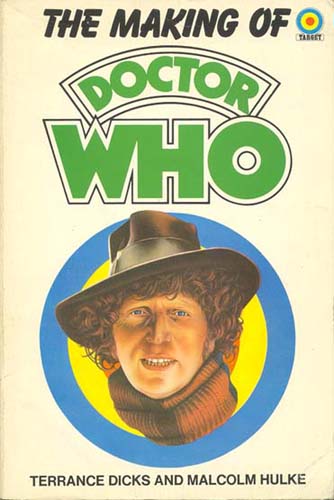The Making of Doctor Who
|
|
Target books The Making of Doctor Who |
| Authors | Terrence Dicks and Malcolm Hulke |  |
| Published | 1976 | |
| ISBN | 0 426 11615 1 | |
| First Edition Cover | Chris Achilleos |
| Summary: Here it is... the story behind one of television's most successful, longest-running shows. Come with DOCTOR WHO on a trip through time... to the early days of the programme when it all began... meet actors, authors and television staff... see inside a TV studio and watch a production take shape... learn the secrets of the monsters... relive every 'Doctor Who' story since the beginning... follow the Doctor through four incarnations and - perhaps - begin to discover just WHO is DOCTOR WHO? |
A piece of history by Tim Roll-Pickering 21/5/02
Recently I discovered a copy of the second edition of this seminal work and was transported back in time to 1976, a time when the average Doctor Who fan was poorly resourced. It was a time before the Programme Guides, before the handbooks, before The Television Companion, before Doctor Who Weekly/Monthly/Magazine, before numerous websites and a giant fan network, before the numerous video releases, before many stories from the earlier years had been novelised. This book was the first reference work for many fans and is truly a piece of history.
Although the book is clearly written for a younger audience than many subsequent reference works, there's much to commend it and indeed there are many areas where it has never really been superseded. The first chapter is about how the series began which is competent and a reasonable summary of events that hasn't been too thoroughly contradicted by more recent research. Other chapters include details about the Daleks, the background to the Doctor, information about the various lead actors, the monsters, UNIT, the companions and some regular cast members before reaching the story guide.
The second edition gives brief synopses of all the stories up until The Hand of Fear, including the number of episodes, the authors, the titles of any novelisations and the story titles. It is this book that was the first piece of 'mainstream' reference to offer an attempted list of the story titles as used by the BBC at the time of production and it is here that several mistakes arose which have resulted in so much debate and confusion over the past twenty-five years. But the second edition is to commended for attempting story titles at all, especially after the first edition bottled out and settled for production codes instead.
The remaining few chapters include a very interesting description of what goes on in a television studio when the series was being recorded, something that is very rarely described elsewhere. There's a chapter detailing the progress of Dicks' Robot from the initial story ideas up to the finish programme as well as the later novelisations. Finally there's a brief overview of the Visual Effects department before a look to the future of the series which also notes that many of the stories by this time were not held by the 'Television Archives'. Finally there is a glossary of technical terms, including some that are well known such as 'Audition' as well as more obscure ones such as 'Inlay'.
Although large parts of this book have long been superseded by more detailed works that have had the benefits of years of reference, there are still some sections such as the description of the television studio which are as readable today as they would have been back in the mid1970s. This book is worthwhile not merely for its historic value but also for these chapters alone. It is definitely worth a look if you come across it. 8/10